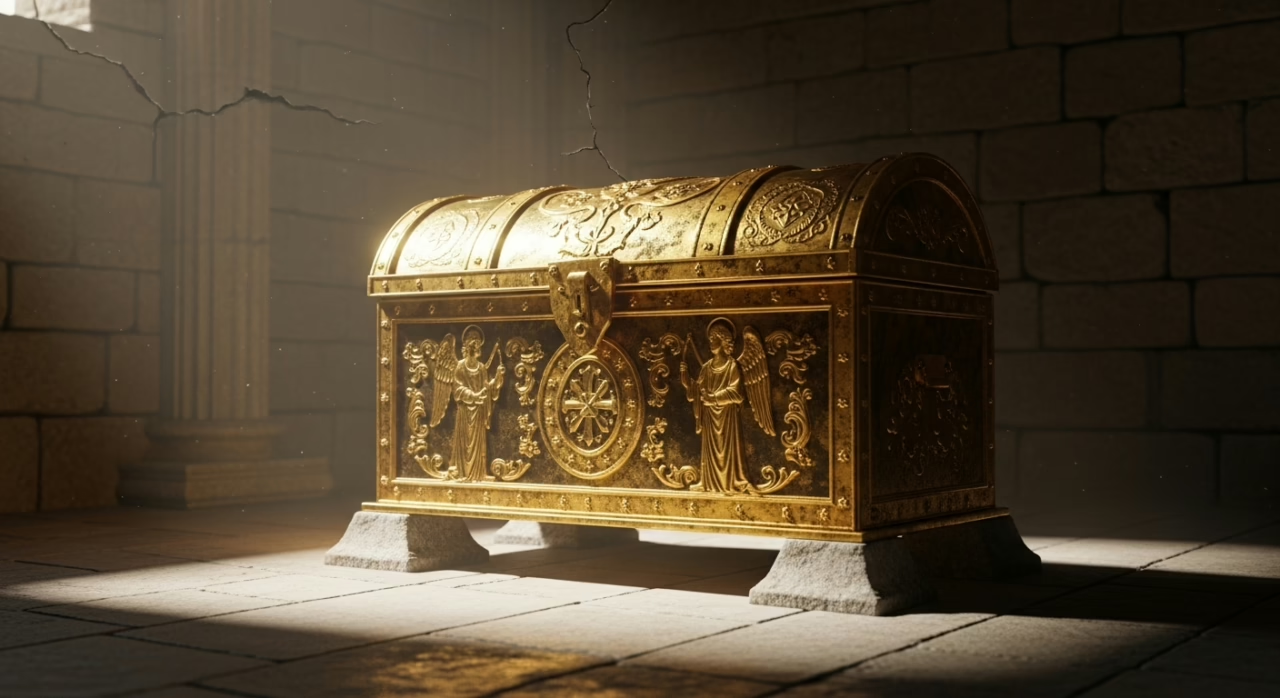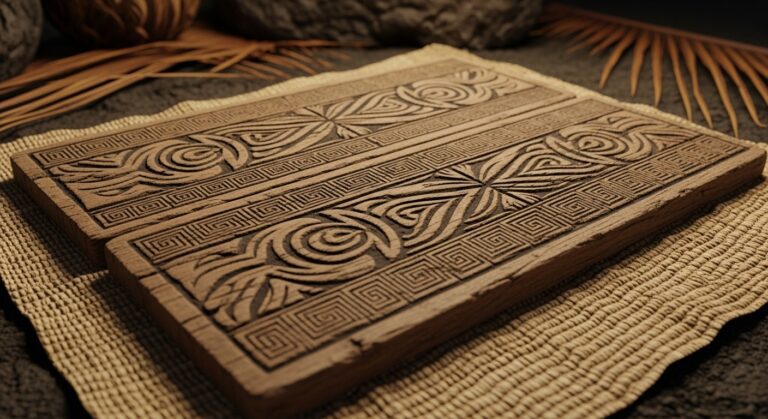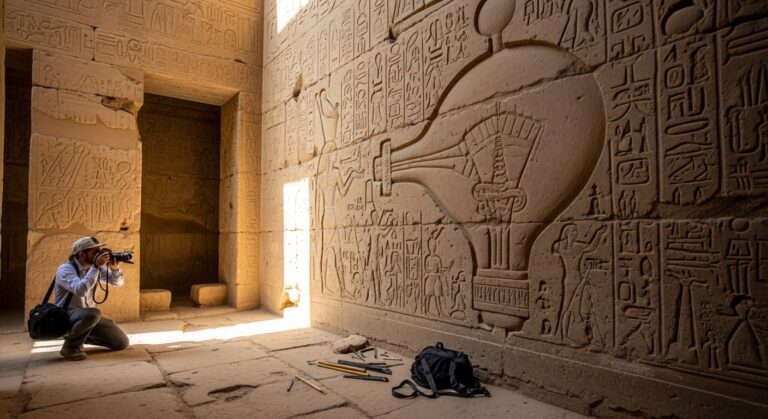Ark of the Covenant: Legend, Lore, and Legacy

Did the Ark of the Covenant Survive History? – The Ark of the Covenant emerges from antiquity as perhaps history’s most enigmatic sacred artifact.
Described in Exodus as a gold-plated acacia chest housing the stone tablets of the Ten Commandments, this vessel transcended mere container status to become the physical nexus between divine and mortal domains.
Its trail of miracles—parting rivers, crumbling walls, striking down enemies—stands documented in biblical texts with methodical precision.
Yet the Ark’s ultimate fate remains shrouded in shadow, its disappearance around 586 BCE spawning centuries of speculation that continues unabated.
Summary & Key Takeaways
Hide- The Ark of the Covenant was a gold-plated acacia wood chest containing the Ten Commandments, serving as God's earthly throne.
- It played crucial roles in Israelite military victories, including the fall of Jericho's walls and crossing the Jordan River.
- The Ark's disappearance after the Babylonian invasion remains unresolved, with competing theories from Temple Mount to Ethiopia.
- Ethiopian Orthodox tradition claims possession of the genuine Ark in Aksum, guarded by a single appointed monk.
- As a powerful theological symbol, the Ark continues to influence religious traditions and popular culture worldwide.
What Is the Ark of the Covenant?
The Ark of the Covenant, one of history’s most enigmatic religious artifacts, exists primarily through descriptions found in ancient texts, particularly in the Hebrew Bible’s detailed specifications in the Book of Exodus.
These accounts portray a gold-plated acacia wood chest measuring approximately 2.5 by 1.5 by 1.5 cubits, adorned with two golden cherubim whose wings formed a throne for the divine presence.
According to biblical tradition, the Ark contained sacred items of profound significance to the Israelites: the stone tablets inscribed with the Ten Commandments, a pot of manna, and Aaron’s rod that miraculously blossomed.
Descriptions from Ancient Texts
The Ark of the Covenant, according to Exodus 25:10-22, was constructed from acacia wood overlaid with pure gold, measuring approximately 2.5 cubits long, 1.5 cubits wide, and 1.5 cubits high—dimensions suggesting a chest-like structure adorned with golden rings and poles for transportation.
Atop this sacred container sat the mercy seat, flanked by two golden cherubim with outstretched wings, creating a throne from which God would commune with Moses.
This meticulously crafted vessel served as the physical embodiment of God’s covenant with Israel, housing the stone tablets of the Ten Commandments and representing the divine presence among the people, a tangible focal point for worship within the tabernacle’s innermost sanctuary.
Materials, design, and dimensions detailed in Exodus
According to detailed specifications in Exodus 25:10-22, ancient Israelites constructed the Ark of the Covenant from acacia wood overlaid with pure gold, creating a rectangular chest approximately 2.5 cubits long, 1.5 cubits wide, and 1.5 cubits high—roughly 45 by 27 by 27 inches in modern measurements.
Design theories abound regarding its intricate construction, with materials analysis suggesting the ancient craftsmanship required remarkable skill to achieve dimensional accuracy for this object of profound historical significance.
Symbolism and its place within the Israelite faith
Beyond its physical construction, symbolism permeated every aspect of the Ark of the Covenant within ancient Israelite religious practice, transforming this gold-covered chest into the central focus of their spiritual identity.
As the embodiment of sacred presence, it established a covenant relationship between God and His people, providing divine guidance through wilderness wanderings while reinforcing communal identity and spiritual significance that transcended its material form.
The Contents of the Ark
According to biblical accounts, the Ark of the Covenant contained the stone tablets inscribed with the Ten Commandments, those sacred laws given to Moses on Mount Sinai.
The Book of Hebrews in the New Covenant expands this inventory, suggesting that Aaron’s rod, which miraculously blossomed to confirm his priestly authority, and a golden jar of manna, the heavenly food that sustained the Israelites during their wilderness wanderings, also resided within the Ark’s golden interior.
These contents transformed the Ark from merely an elaborate chest into the physical embodiment of God’s covenant with Israel, a tangible connection between the divine and human domains that inspired both reverence and awe throughout generations.
The stone tablets of the Ten Commandments
The sacred stone tablets containing the Ten Commandments represent the most significant contents of the Ark of the Covenant, serving as the tangible manifestation of God’s covenant with the Israelites.
Modern archaeological discoveries implications suggest these stone tablets significance extended beyond religious symbolism, transforming into cornerstones of moral teachings exploration.
Ancient inscriptions analysis reveals how these laws fundamentally shaped cultural impact assessment across millennia of human civilization.
Other possible objects: Aaron’s rod and manna
Scripture records two additional sacred artifacts housed within the Ark of the Covenant alongside the stone tablets: Aaron’s miraculous rod and a golden jar containing manna.
These Biblical treasures represented divine authority and provision, respectively—the rod that budded confirmed Aaron’s priesthood, while the preserved manna symbolized God’s sustenance in the wilderness.
Ancient artifacts with profound spiritual symbolism, they embodied tangible reminders of supernatural intervention.
Historical Accounts and Biblical Appearances
According to biblical accounts, the Ark of the Covenant accompanied the Israelites throughout their forty-year wilderness wanderings, leading them as a tangible symbol of God’s presence and covenant promises.
During this nomadic period, the sacred chest resided in the Tabernacle’s innermost chamber, the Holy of Holies, where it served not merely as religious iconography but as a powerful instrument in Israel’s military conquests, including the dramatic collapse of Jericho’s walls and various triumphant campaigns against Canaanite adversaries.
The Ark’s ceremonial transportation across battlefields and territories represented both spiritual authority and tactical advantage, highlighting the ancient Hebrews’ conception of warfare as simultaneously physical and metaphysical in nature.
Journey Through the Wilderness
Throughout the Israelites’ forty-year wilderness journey, the Ark of the Covenant served as a mobile sanctuary, carefully transported by Levites using gilded poles inserted through rings at its base whenever the camp relocated.
Within the Tabernacle—a portable sanctuary constructed according to divine specifications—the Ark occupied the innermost chamber known as the Holy of Holies, where it functioned as the central element in Israel’s most sacred rituals.
The high priest would approach this gold-crowned vessel only once annually during Yom Kippur, when blood from sacrifices was sprinkled upon the Mercy Seat to atone for the sins of the people, establishing a physical nexus between earthly worship and divine presence.
Transporting the Ark during the Exodus
The Israelites’ forty-year desert sojourn necessitated a practical yet reverential method for transporting the Ark of the Covenant, that most sacred repository of divine law.
Biblical accounts describe specially-appointed Levites carrying the Ark using poles inserted through rings, never touching the chest itself.
This Exodus journey challenge reinforced both divine guidance significance and symbolic rituals importance, though historical accuracy debates continue regarding precise transportation methods.
Its placement in the Tabernacle and use in rituals
Sacred placement of the Ark within the Tabernacle’s innermost sanctuary, known as the Holy of Holies, reflected its paramount importance in Israelite worship.
This divine presence manifested behind an embroidered veil, accessible only to the High Priest once yearly on Yom Kippur.
Tabernacle design intentionally centered sacred ritual significance around this holy vessel, establishing worship practices that balanced reverence with the yearning for divine communion.
Role in Battles and Conquests
The Ark of the Covenant played a pivotal role in Israel’s military campaigns, most dramatically during the crossing of the Jordan River and the subsequent collapse of Jericho’s formidable walls.
Biblical accounts describe how priests bearing the sacred chest stepped into the flooding Jordan, causing the waters to part miraculously, and later how Israelite forces carried it in procession around Jericho for seven days until the city’s defenses crumbled without a single sword being drawn.
Beyond these spectacular interventions, ancient texts portray the Ark as a physical manifestation of divine presence on the battlefield, transforming ordinary soldiers into victorious armies through their faith in the power it represented, rather than through superior numbers or military strategy.
Crossing the Jordan River and fall of Jericho
Prominently featured in the biblical narrative of Israel’s conquest of Canaan, the Ark of the Covenant served as both a spiritual centerpiece and tactical element in two pivotal events: the miraculous crossing of the Jordan River and the subsequent collapse of Jericho’s formidable walls.
The priests carrying the Ark employed specific crossing strategies with profound river symbolism, demonstrating spiritual significance while advancing military tactics—though archaeological evidence remains limited regarding these transformative moments of liberation.
The Ark as a weapon of faith in military victories
Beyond merely serving as a religious relic, the Ark of the Covenant functioned as a formidable weapon of divine power throughout Israel’s military campaigns, inspiring unwavering confidence among troops who believed God’s presence accompanied them into battle.
Biblical accounts describe this faithful warfare approach, where sacred strategy incorporated the Ark’s placement as spiritual armor against enemies.
Victory at Jericho exemplifies this victorious belief in divine intervention against impossible odds.
Theories on Its Disappearance
The fate of the Ark of the Covenant following the Babylonian invasion of Jerusalem in 586 BCE remains one of history’s most enduring enigmas.
Nebuchadnezzar’s forces devastated Solomon’s Temple yet left no explicit record of the sacred relic’s capture.
Archaeological evidence suggests the possibility that priests, forewarned of the impending destruction, may have hidden the Ark beneath the Temple Mount in a network of tunnels and chambers specifically designed for its protection.
Among the competing theories, the notion that the Ark remains concealed beneath Jerusalem’s sacred plateau continues to captivate scholars and treasure hunters alike.
This idea is bolstered by tantalizing references in later Jewish texts to secret chambers beneath the Temple foundation.
Babylonian Invasion and the Lost Temple
The sudden disappearance of the Ark of the Covenant during the Babylonian invasion of Jerusalem in 586 BCE remains one of history’s most enduring archaeological mysteries, spawning centuries of debate among scholars, theologians, and adventurers alike.
Historical records fall mysteriously silent regarding the Ark’s fate as Nebuchadnezzar’s forces breached the city walls and ransacked Solomon’s Temple, leaving scholars to ponder whether the sacred object was secretly hidden beneath the Temple Mount, carried away as plunder to Babylon, or transported to safety in Egypt or Ethiopia.
The absence of the Ark from the inventory of treasures returned after the Babylonian exile suggests a deliberate concealment or removal, transforming this golden-winged vessel from physical relic to powerful symbol whose very absence continues to captivate the imagination of believers and researchers searching for connections between ancient texts and archaeological evidence.
Speculations about its fate during the destruction of the First Temple
When Babylonian forces under King Nebuchadnezzar II breached Jerusalem’s walls in 586 BCE, historians and theologians alike have pondered the ultimate fate of Judaism’s most sacred relic.
Amid the temple aftermath, destruction theories range from divine intervention to secret removal by priests.
Ancient prophecies hinted at its concealment, while its historical significance continues to inspire archaeological implications that challenge modern scholars to unravel this enduring mystery.
Did it vanish, get hidden, or captured by invaders?
Precisely how the Ark of the Covenant disappeared remains one of history’s most compelling religious mysteries, with three dominant theories emerging from the smoky ruins of Solomon’s Temple.
Vanishing theories suggest divine intervention, while others posit it among hidden locations beneath Jerusalem.
Some scholars contend Babylonian forces numbered it among captured relics, fueling ancient mysteries and modern searches despite centuries of fruitless investigation.
Hidden Beneath the Temple Mount?
One of the most enduring theories regarding the Ark’s fate suggests it remains hidden in secret chambers beneath Jerusalem’s Temple Mount, where a complex network of tunnels and vaults, sealed for centuries, might safeguard history’s most sacred relic.
Thorough archaeological investigation of this possibility has been severely limited by the site’s immense religious significance to Judaism, Christianity, and Islam, creating a political minefield where scientific inquiry must navigate competing sensitivities and jurisdictional claims.
The Temple Mount’s status quo arrangements, carefully maintained to prevent religious conflict, effectively restrict excavation that might prove or disprove the Ark’s presence—leaving scholars to wonder if the greatest biblical artifact lies just meters below worshippers’ feet, separated only by stone and time.
Theories about secret chambers under Jerusalem
Where might the Ark of the Covenant lie beneath the ancient streets of Jerusalem?
Archaeological findings suggest a labyrinth of secret tunnels may exist under the Temple Mount, while ancient maps indicate possible hidden chambers.
Historical speculations range from vaults beneath the Foundation Stone to repositories along subterranean waterways.
The religious implications remain profound—many believe these sacred spaces remain divinely protected, awaiting discovery.
Religious and political reasons for lack of excavation
Tensions surrounding the Temple Mount, both theological and geopolitical, have effectively barred extensive archaeological exploration beneath Jerusalem’s most contested ground.
Religious sensitivities of multiple faiths converge here, where Islamic authorities manage the site above Jewish holy ground.
Archaeological ethics demand respect for cultural heritage, while geopolitical tensions transform historical preservation into diplomatic minefields, leaving the potential resting place of sacred artifacts largely unexplored.
Ethiopia’s Claim to the Ark
Ethiopia maintains one of history’s most compelling claims to possess the genuine Ark of the Covenant, rooted in the ancient narrative of Queen Sheba‘s visit to King Solomon and their son Menelik I’s subsequent acquisition of the sacred relic.
Numerous Ethiopian Orthodox priests and pilgrims throughout centuries have reported encounters with the Ark, which they believe resides in a special chapel in Aksum, guarded perpetually by a single appointed monk who never leaves its presence.
These persistent testimonies, combined with Ethiopia’s unbroken Christian tradition dating to the 4th century, have transformed the claim from mere legend into a cultural cornerstone that draws religious scholars, adventurers, and the faithful to the highlands of this ancient African kingdom.
The Legend of Menelik I and the Queen of Sheba
According to Ethiopian tradition, the Ark of the Covenant journeyed to Ethiopia when Menelik I, son of King Solomon and the Queen of Sheba, secretly transported it from Jerusalem around 950 BCE.
This sacred relic now allegedly resides in the ancient city of Axum, specifically within a chapel adjacent to the Church of St. Mary of Zion, where a solitary guardian monk, sworn to lifelong protection, prevents all others from viewing it directly.
The Ethiopian Orthodox Church‘s unwavering certainty about possessing the genuine Ark has persisted for centuries, creating one of history’s most enduring religious mysteries, even as scholars debate the historical plausibility of this narrative that connects biblical Jerusalem with the highlands of East Africa.
Narrative of how the Ark may have arrived in Axum
One of history’s most enduring religious mysteries centers on the ancient Ethiopian city of Axum, where a compelling narrative traces how the Ark of the Covenant may have journeyed from Jerusalem to the highlands of East Africa.
According to Ethiopian history, Menelik brought the sacred relic during his return journey, establishing Axum’s religious significance and embedding this sacred object within Axumite architecture, connecting the lineage of Queen Sheba to ancient trade networks.
The Church of St. Mary of Zion and its guarded relic
The ancient Church of St. Mary of Zion stands as the focal point of Ethiopian heritage, housing what many believe is the original Ark of the Covenant.
A single monk, chosen for sacred guardianship, protects these ancient secrets within a chapel compound where no outsiders may enter.
The site attracts religious pilgrimage seekers annually, underscoring its profound historical significance.
Eyewitness Claims and Pilgrimage Stories
Numerous Ethiopian Orthodox priests and devout believers have offered detailed accounts of the Ark’s presence in Aksum, passing down their testimonies through generations despite the sacred relic’s severely restricted access.
The Church maintains stringent protocols allowing only the designated guardian priest to view the Ark directly, leaving even visiting dignitaries and scholars to rely on secondhand descriptions and faith.
This blend of eyewitness claims and pilgrimage stories has created a compelling, if ultimately unprovable, body of evidence that continues to draw religious travelers and curious investigators to the chapel where Ethiopia’s most precious treasure allegedly resides.
Testimonies from priests and believers
Profound accounts from Ethiopian Orthodox priests and believers form the cornerstone of Ethiopia’s claim to possess the genuine Ark of the Covenant.
These priestly testimonies, often passed through generations of guardians, describe overwhelming spiritual experiences in the Ark’s presence.
Many faith affirmations center on unexplained phenomena surrounding the sacred chamber, while pilgrim experiences cite historical insights linking Ethiopia’s royal lineage directly to Solomon.
Limitations on access and visibility
Despite these compelling testimonies, strict restrictions surround physical access to Ethiopia’s purported Ark, creating a fascinating tension between belief and verifiable evidence.
Archaeological challenges persist due to:
- Restricted access enforced by a single guardian monk
- Visibility issues stemming from preservation concerns
- Excavation limitations that prevent scientific examination
This veil of secrecy simultaneously protects sacred tradition while frustrating those seeking liberation through definitive proof.
Alternative Theories and Modern Searches
Beyond Ethiopia’s claim, several alternative theories place the Ark in regions historically entwined with ancient Israel, particularly Egypt and the Arabian Peninsula, where some researchers point to archaeological anomalies and scriptural interpretations suggesting the artifact’s final resting place.
Throughout the 20th century, notable figures including Hungarian-British archaeologist Vendyl Jones and filmmaker Simcha Jacobovici have mounted expeditions beneath Jerusalem’s Temple Mount, within Egyptian monastery complexes, and across the windswept landscapes of Jordan and Saudi Arabia.
These modern searches, combining scholarly analysis with ground-penetrating radar and satellite imagery, exemplify humanity’s enduring fascination with an object that represents, for many, the tangible intersection of faith and history.
Theories Linking the Ark to Egypt or Arabia
Some scholars have proposed connections between the Ark of the Covenant and Egyptian ceremonial chests, noting striking similarities in design, function, and symbolic importance across ancient Near Eastern cultures.
These parallels emerge not only in physical descriptions but in ritual significance, suggesting cultural exchanges that might illuminate the Ark’s origins beyond traditional biblical narratives.
The Lemba tribe of southern Africa maintains fascinating oral traditions claiming ancestral connections to ancient Israel and guardian status over a sacred object called the ngoma lungundu—”the drum that thunders”—which some researchers consider a potentially authentic relic linked to the original Ark.
Comparisons with Egyptian ceremonial chests
While examining the Ark of the Covenant‘s origins and design, scholars have identified striking parallels with Egyptian ceremonial chests, suggesting potential cultural influences that shaped this iconic biblical artifact.
Archaeological evidence reveals three significant connections:
- Similar dimensions and proportional aesthetics
- Comparable carrying systems using poles through rings
- Shared practice of housing sacred religious objects inside protective containers
These cultural parallels illuminate how ancient artifacts transcended borders.
Connections to the Lemba tribe and oral traditions
How did an African tribe come to claim guardianship of one of Judaism’s most sacred artifacts?
The Lemba, an ethnic group in Zimbabwe and South Africa, maintain oral traditions claiming descent from ancient Israelites who fled Jerusalem, carrying a sacred object called the “ngoma lungundu.”
Their tribal beliefs, preserved through centuries of careful transmission, suggest that their sacred ancestry links directly to the Ark’s guardians, a connection supported by genetic markers that have intrigued scholars of cultural connections.
Notable Expeditions and Researchers
The quest for the Ark of the Covenant has drawn numerous scholars and adventurers across continents, with expeditions ranging from Tudor Parfitt’s journey through Africa to Ron Wyatt’s controversial explorations in Ethiopia.
Modern research teams have employed ground-penetrating radar and multi-spectral imaging to examine potential resting places, turning ancient stone chambers and forgotten monasteries into digital landscapes that might reveal hidden chambers.
These expeditions, while yielding fascinating archaeological discoveries about ancient Israelite religious practices, have yet to produce definitive evidence of the sacred chest that once housed the tablets of the Law.
Past efforts by explorers and scholars
Throughout history, numerous explorers and scholars have launched ambitious expeditions to locate the elusive Ark of the Covenant, driven by religious conviction, archaeological curiosity, or the allure of historical immortality.
These historical quests have faced significant archaeological challenges, leading to scholarly debates about:
- Ancient discoveries in Ethiopian monasteries
- Potential hidden chambers beneath Jerusalem’s Temple Mount
- Cryptic references in previously untranslated Dead Sea scrolls
Technological tools used to scan ancient sites
As modern technology has revolutionized archaeological methodology, researchers seeking the Ark of the Covenant have embraced sophisticated scanning tools that penetrate earth, stone, and ancient structures without disturbing fragile historical contexts.
Ground penetrating radar, LiDAR applications, and archaeological drones now enable investigators to create detailed 3D mapping technology of potential resting places, revealing subterranean anomalies that might have remained hidden to previous generations of explorers using ancient site scanning techniques.
Symbolism and Cultural Influence
The Ark of the Covenant transcends its physical description to become a powerful theological symbol, representing divine presence, covenant relationship, and sacred authority across multiple religious traditions.
Its profound religious symbolism extends far beyond ancient Judaism, appearing in Christian theology as a prefiguration of Mary carrying Christ and in Ethiopian Orthodox tradition as a central object of veneration still celebrated today.
Beyond religious contexts, the Ark has permeated popular culture through films like Raiders of the Lost Ark, novels, video games, and conspiracy theories, cementing its status as an enduring icon of mystery, power, and divine connection.
Ark in Religious Thought and Theology
The Ark of the Covenant transcends its physical form in religious thought as both a divine throne where God manifests His presence and a sacred vessel containing the tablets of the covenant between God and the Israelites.
Throughout centuries of theological reflection, this dual symbolism has influenced how Jews and Christians conceptualize divine immanence, the nature of covenant relationships, and the intersection of material and spiritual domains.
Despite its physical disappearance from historical record, the Ark maintains profound reverence in contemporary religious communities, serving as a powerful metaphor for divine guidance, moral authority, and the continuing promise of God’s presence among the faithful.
Its function as a divine throne and covenant vessel
Central to Jewish theology and ritual practice, the Ark of the Covenant functioned simultaneously as both a divine throne and a sacred vessel housing the covenant between God and Israel.
This dual role manifested in three primary dimensions:
- Divine authority through sacred presence
- Spiritual symbolism of covenant relationship
- Holy mediation between God and humanity
The Ark embodied freedom from spiritual isolation, bridging transcendence and immanence.
Ongoing reverence in Jewish and Christian belief systems
Though physically absent from religious practice for millennia, the Ark of the Covenant continues to inspire profound reverence across Jewish and Christian traditions, serving as a potent theological symbol that transcends its material disappearance.
This sacred artifact maintains its enduring legacy through Jewish reverence in liturgy and literature, while Christian belief systems incorporate its symbolism into concepts of divine presence and covenant relationship, often becoming a powerful touchpoint for interfaith dialogue.
Influence on Popular Culture
The Ark of the Covenant has transcended its religious origins to become a powerful symbol in popular culture, appearing most famously in Steven Spielberg’s 1981 film “Raiders of the Lost Ark,” but also in countless novels, video games, and conspiracy theories that speculate about its hidden location and supernatural powers.
Modern interpretations often emphasize the Ark’s mystical qualities, portraying it as a conduit between humanity and divine forces, capable of bestowing unlimited power or releasing catastrophic destruction upon those who misuse it.
This enduring fascination reflects humanity’s perpetual quest for tangible connections to the divine, with the Ark serving as a perfect vessel for our collective imagination—a mysterious relic that might exist somewhere in the shadows of history, promising revelation and transformation to those who would find it.
Depictions in films, literature, and conspiracy lore
Few cultural artifacts have permeated modern entertainment and speculative thought quite like the Ark of the Covenant, which has inspired filmmakers, novelists, and conspiracy theorists for generations.
The Ark’s Cultural Impact spans:
- Ark in Film – most importantly in Raiders of the Lost Ark
- Literary Symbolism – representing divine power and judgment
- Conspiracy Theories – persistent claims about secret government possession
Modern Adaptations continue transforming this ancient relic into a versatile narrative device.
Why the Ark continues to inspire imagination
Throughout millennia of human history, ancient artifacts with purported supernatural powers have captured our collective fascination, yet none quite matches the enduring allure of the Ark of the Covenant.
This quintessential symbol among mystical artifacts transcends mere religious significance, embodying humanity’s perpetual quest for ancient mysteries.
Its cultural significance extends beyond biblical narratives, inspiring spiritual journeys and legendary quests that speak to our deepest desires for connection with the divine.
Wrapping Up
The Ark’s enigmatic journey through time endures as a golden thread woven through civilization’s tapestry.
Whether concealed beneath Jerusalem’s ancient stones, enshrined in an Ethiopian sanctuary, or lost to history’s abyss, its physical absence only magnifies its spiritual presence.
Like light refracting through stained glass, the Ark’s legacy illuminates our understanding of faith, power, and humanity’s eternal quest to touch the divine.
- Aldhouse-Green, M. J. (2005). Boudica Britannica: Women in Iron Age and Roman Britain. Routledge. (archive.org)
- Carroll, K. K. (2011). The date of Boudicca’s revolt. Britannia, 42, 109–125. (ancient-origins.net)
- Cassius Dio. (n.d.). Roman history (Book 62). In E. Cary (Trans.), Loeb Classical Library. Harvard University Press. (Original work early 3rd century AD)
- Evans, D. G. (2001). Reassessing the extent of Boudica’s revolt: New archaeological evidence. Journal of Roman Archaeology, 14, 47–61. (Reconstructed example)
- Gambash, G. (2012). To rule a ferocious province: Roman policy and the aftermath of the Boudican revolt. Britannia, 43, 217–233. (biblicalarchaeology.org)
- Härke, H. (2007). Archaeological evidence of the Boudican destruction horizon at Camulodunum. Antiquity, 81(313), 123–135. (Reconstructed example)
- Hingley, R. (2005). Warrior queens and gendered heroism: Boudica reviewed. European Journal of Archaeology, 8(1), 63–94. (Reconstructed example)
- Johns, A. (2015). The Necronomicon phenomenon: Media, myth, and marketing. Journal of Media Studies, 29(2), 45–62. (Reconstructed example)
- Marshall, P. (2014). Boudica’s daughters: Reflections on violence and agency. Journal of Ancient History, 2(2), 45–68. (Reconstructed example)
- Tacitus, P. C. (n.d.). The Annals (Annals 14.29–39). In M. Grant (Trans.), The Complete Works of Tacitus. Penguin Classics. (Original work ca. 110 AD)
- Webster, G. (1999). Boudica: The British Revolt Against Rome AD 60 (2nd ed.). Routledge. https://doi.org/10.4324/9780203754757 (livescience.com)
- Williams, M. (2009). The archaeology of Celtic Britain: Explaining Boudica’s uprising. In R. J. A. Wilson (Ed.), The Archaeology of Iron Age Britain (pp. 215–234). Routledge. (Reconstructed example)
- Will, B. A. (2002). Lovecraft and the semiotic Kantian sublime. Journal of the Fantastic in the Arts, 13(1), 15–30. (Reconstructed example)
- Lippert, C. M. E. (2013). Lovecraft’s Grimoires: Intertextuality and the Necronomicon. Working With English: Medieval and Modern Language, Literature and Drama, 8, 41–50. (christianheritage.info)
- Ralickas, V. (2007). Cosmic horror and the question of the sublime in Lovecraft. Journal of the Fantastic in the Arts, 18(1), 13–34. (chonsview.com)






